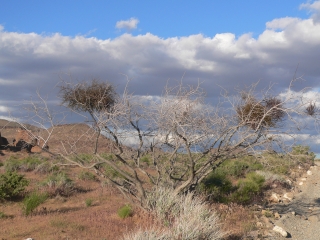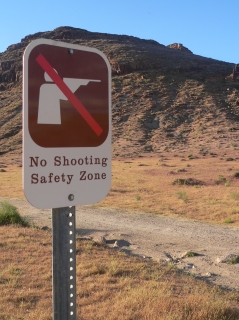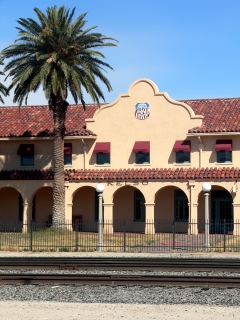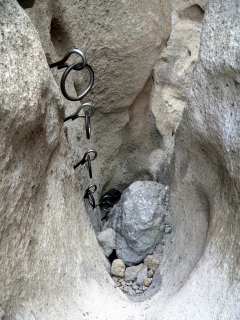NPS Website; Local Website
 WHAT IS IT?
WHAT IS IT?1.6-million acres of high country California desert wilderness. The Mojave, Great Basin and Sonoran deserts meet here creating subtle but distinct biological diversity.
BEAUTY (6/10)
The Mojave National Preserve is big. Of the continental U.S. National Parks, only Death Valley NP and Yellowstone NP are bigger. The Mojave N PRES is of equal size to Everglades NP and has a crazy range of ecological habitats: Joshua tree forests, lava fields, sand dunes, sage scrub brushes, pinyon-juniper forests and yucca-cactus scrub fields.
The beauty illuminates when the rich blues of the big sky contrast with the tans, dull greens and browns of the land below. This winter’s abnormally high rains have brought more colors to the desert floor as pinks, purples, oranges, yellows and reds dot the roadsides. The California desert wildflowers have been the rage this year, but if you haven’t been there yet, you have probably missed them.
HISTORICAL INTEREST (2/10)
A few mining and farming operations is it.
 CROWDS (4/10)
CROWDS (4/10)This Park is a National Preserve which means, among other things, that far fewer rules apply than at National Parks. Most notable among the difference is that you can hunt in a National Preserve. We had planned to visit the Mojave N PRES back in October but the Ranger at their Baker VC advised us against it. We obliged. Hiking on public lands where people are legally shooting high-powered rifles is not our idea of fun. Crowds forced us to delay our trip for six months.
We should have expected a loud an unruly crowd at the Hole-in-the-Wall campground; enough people had suggested we stay elsewhere.
National Preserves are also unique in that people still live inside of them. Much of the land is still private property so be careful where you hike.
EASE OF USE/ACCESS (2/5)
You might know the Mojave N PRES as that desolate area to your right while you are stuck on Interstate 15 on your way to Las Vegas. The Preserve encompasses the expanse of land between Interstates 15 and 40 from Baker all the way east to the Nevada border. It is an area of land larger than Everglades NP. Death Valley NP and Yellowstone NP are the only Park Sites with more land.
Because the Park is wedged between two Interstates, access is possible. Las Vegas and Laughlin are less than 60 miles from a Park entrance. Mojave N PRES’ interior, however, can pose problems. Only about half of the roads are paved, and a few only accessible to experience ORVers.
There are also not many designated hiking trails. Cool if you want to explore, not cool if you are like us and need some guidance. According to the Park Newspaper, the Preserve has only five developed trails accessible via paved road. Three of those are less than a mile round trip. The six other trail routes the paper recommends must be accessed via 4x4.
We were very disappointed that the refurbished Kelso Depot is not yet open to the public. It was scheduled to open in late 2004 but still has not seen its first tourist.
 CONCESSIONS/BOOKSTORE (2/5)
CONCESSIONS/BOOKSTORE (2/5)The Hole-in-the-Wall Information Center bookstore carries a nice, but limited, collection of local interest books. There are about a half-dozen Mojave Desert books and over ten that detail the Southern Paiute Indians. Other books go into rock art, ghost towns, mining and all things desert.
Stuffed jackrabbits, Gila monsters, California quail, coyote and desert tortoise are on sale for the kids. Who doesn’t love stuffed animals?
The Hole-in-the-Wall Information Center is the only place inside the Park’s 1.6 million acres where you can buy anything. There is no gas, no food and no lodging here. Plan accordingly and always carry water.
COSTS (4/5)
The Park is free.
Both the 35-site Hole-in-the-Wall Campground and the 26-site Mid Hills Campground cost $12 per night. You can camp for free along many of the park roads; it just has to be in a place that has been used before. Ask a Ranger to point out the free sites’ locations.
RANGER/GUIDE TO TOURIST RATIO (3/5)
Few people visit the Mojave Preserve. Nonetheless, on both visits we received helpful info from Rangers at both the Mojave N PRES Visitor Center (in Baker, Calif.) and the Hole-in-the-Wall Info Center (in the Park at Hole-in-the-Wall). The Baker Ranger thankfully told us not to enter the Park because of hunting season while the Hole-in-the-Wall Ranger marked every roadside camping spot for us on the map.
Make sure you stop at one of these VC’s before you start exploring the Preserve.
TOURS/CLASSES (2/10)
No displays at any of the Info Centers we visited. A short hike between the Hole-in-the-Wall VC and campground has a nice self-guided trail pamphlet that identifies over 30 species of desert plant life.
 FUN (4/10)
FUN (4/10)The Mojave N PRES is the kind of place where SUV owners can justify their purchase and have fun with their 4x4 toy. Compact Japanese car owners are not so lucky. While driving for 15 long miles along the unpaved Black Canyon Road we were so preoccupied with the rough terrain that we failed to appreciate the striking scenery that surrounded us.
We wanted to see the Kelso Dunes, sand dunes that boom when dry sand slides down the upper slopes, but balked at the four-mile unpaved road that leads to their base. After a quarter mile of rough dirt washboard road, we turned around.
The Park, so promising in theory, was quite inhospitable in practice.
We did enjoy the Rings Trail, located near the Hole-in-the-Wall Information Center. The trail goes straight down canyon crevices on metal rings that have been fastened onto the rock wall. If we had seen an elusive desert tortoise, we would have been ecstatic.
WOULD WE RECOMMEND? (3/10)
Not unless you know what you are getting into: barren climate, no services, few established trails and mostly dirt roads. Plain and simple, it is the desert. The Mojave N PRES is where you come to escape everything.
TOTAL 32/80
www.usa-c2c.com
© 2005